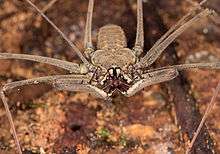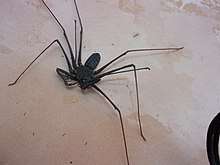Heterophrynus
Heterophrynus is a genus of whip spiders, also known as tailless whip scorpions (order Amblypygi), of the family Phrynidae. It is mostly distributed in South America.
| Heterophrynus | |
|---|---|
 | |
| Indeterminate species of Heterophrynus from Ecuador | |
| Scientific classification | |
| Kingdom: | Animalia |
| Phylum: | Arthropoda |
| Subphylum: | Chelicerata |
| Class: | Arachnida |
| Order: | Amblypygi |
| Family: | Phrynidae |
| Subfamily: | Heterophryninae |
| Genus: | Heterophrynus Pocock, 1894 |
| Type species | |
| Heterophrynus cheiracanthus Gervais, 1842 | |
Species

There are 16 species:[1]
- Heterophrynus alces Pocock, 1902
- Heterophrynus armiger Pocock, 1902
- Heterophrynus batesii Butler, 1873
- Heterophrynus boterorum Giupponi & Kury, 2013
- Heterophrynus caribensis Armas, Torres-Contreras & Alvarez Garcia, 2015
- Heterophrynus cervinus Pocock, 1894
- Heterophrynus cheiracanthus Gervais, 1842 (type species)
- Heterophrynus elaphus Pocock, 1903
- Heterophrynus gorgo Wood, 1869
- Heterophrynus guacharo de Armas, 2015
- Heterophrynus longicornis Butler, 1873
- Heterophrynus pumilio C.L. Koch, 1840
- Heterophrynus seriatus Mello-Leitão, 1940
- Heterophrynus silviae Giupponi & Kury, 2013
- Heterophrynus vesanicus Mello-Leitão, 1931
- Heterophrynus yarigui Alvarez Garcia, de Armas & Diaz Perez, 2015
gollark: What if I don't want to?
gollark: They just don't make sense. Do they go up or down or sideways? What if I put in a really, really big number - can it reach the thing it asymptotically tends towards *then*? What if I want it to output a different value? Are bees holomorphic?
gollark: However, I don't know how asymptotes work, so I'm just going for slightly increasing it each time.
gollark: It must asymptotically approach 6.1 as it approaches completion.
gollark: 6.00000000003.
References
- Bisby F.A.; Roskov Y.R.; Orrell T.M.; Nicolson D.; Paglinawan L.E.; Bailly N.; Kirk P.M.; Bourgoin T.; Baillargeon G.; Ouvrard D. (red.) (2011). "Species 2000 & ITIS Catalogue of Life: 2011 Annual Checklist". Species 2000: Reading, UK. Retrieved 30 June 2019.
| Wikimedia Commons has media related to Heterophrynus. |
This article is issued from Wikipedia. The text is licensed under Creative Commons - Attribution - Sharealike. Additional terms may apply for the media files.